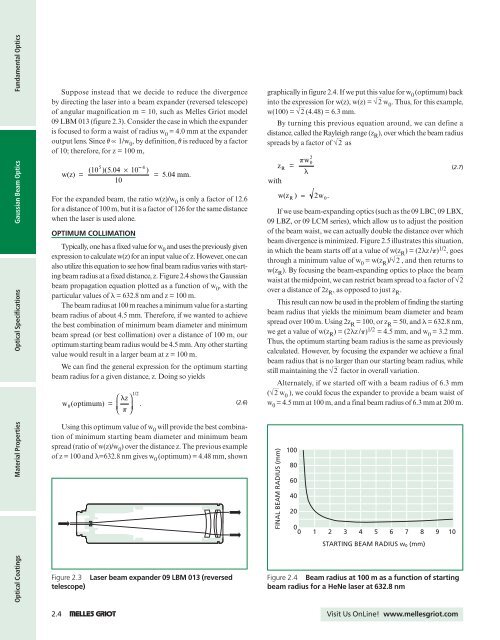Optical Coatings
Optical Coatings
Optical Coatings
Create successful ePaper yourself
Turn your PDF publications into a flip-book with our unique Google optimized e-Paper software.
Fundamental Optics<br />
Material Properties <strong>Optical</strong> Specifications Gaussian Beam Optics<br />
Suppose instead that we decide to reduce the divergence<br />
by directing the laser into a beam expander (reversed telescope)<br />
of angular magnification m = 10, such as Melles Griot model<br />
09 LBM 013 (figure 2.3). Consider the case in which the expander<br />
is focused to form a waist of radius w 0 = 4.0 mm at the expander<br />
output lens. Since v ∝ 1/w 0 , by definition, v is reduced by a factor<br />
of 10; therefore, for z = 100 m,<br />
For the expanded beam, the ratio w(z)/w 0 is only a factor of 12.6<br />
for a distance of 100 m, but it is a factor of 126 for the same distance<br />
when the laser is used alone.<br />
OPTIMUM COLLIMATION<br />
Typically, one has a fixed value for w 0 and uses the previously given<br />
expression to calculate w(z) for an input value of z. However, one can<br />
also utilize this equation to see how final beam radius varies with starting<br />
beam radius at a fixed distance, z. Figure 2.4 shows the Gaussian<br />
beam propagation equation plotted as a function of w 0 , with the<br />
particular values of l = 632.8 nm and z = 100 m.<br />
The beam radius at 100 m reaches a minimum value for a starting<br />
beam radius of about 4.5 mm. Therefore, if we wanted to achieve<br />
the best combination of minimum beam diameter and minimum<br />
beam spread (or best collimation) over a distance of 100 m, our<br />
optimum starting beam radius would be 4.5 mm. Any other starting<br />
value would result in a larger beam at z = 100 m.<br />
We can find the general expression for the optimum starting<br />
beam radius for a given distance, z. Doing so yields<br />
w (optimum) =<br />
0<br />
5 5 4<br />
w(z) = (10 )( 504 . × 10 )<br />
= 5.04 mm.<br />
10<br />
1/2<br />
⎛ lz<br />
⎞<br />
⎜<br />
⎝ p<br />
⎟ . (2.6)<br />
⎠<br />
Using this optimum value of w 0 will provide the best combination<br />
of minimum starting beam diameter and minimum beam<br />
spread (ratio of w(z)/w 0 ) over the distance z. The previous example<br />
of z = 100 and l=632.8 nm gives w 0 (optimum) = 4.48 mm, shown<br />
graphically in figure 2.4. If we put this value for w 0 (optimum) back<br />
into the expression for w(z), w(z) = √}}2 w 0 . Thus, for this example,<br />
w(100) = √}}2 (4.48) = 6.3 mm.<br />
By turning this previous equation around, we can define a<br />
distance, called the Rayleigh range (z R ), over which the beam radius<br />
spreads by a factor of √}}2 as<br />
z R =<br />
with<br />
If we use beam-expanding optics (such as the 09 LBC, 09 LBX,<br />
09 LBZ, or 09 LCM series), which allow us to adjust the position<br />
of the beam waist, we can actually double the distance over which<br />
beam divergence is minimized. Figure 2.5 illustrates this situation,<br />
in which the beam starts off at a value of w(z R ) = (2lz/p) 1/2 , goes<br />
through a minimum value of w 0 = w(z R )/√}}2 , and then returns to<br />
w(z R ). By focusing the beam-expanding optics to place the beam<br />
waist at the midpoint, we can restrict beam spread to a factor of √}}2<br />
over a distance of 2z R , as opposed to just z R .<br />
This result can now be used in the problem of finding the starting<br />
beam radius that yields the minimum beam diameter and beam<br />
spread over 100 m. Using 2z R = 100, or z R = 50, and l = 632.8 nm,<br />
we get a value of w(z R ) = (2lz/p) 1/2 = 4.5 mm, and w 0 = 3.2 mm.<br />
Thus, the optimum starting beam radius is the same as previously<br />
calculated. However, by focusing the expander we achieve a final<br />
beam radius that is no larger than our starting beam radius, while<br />
still maintaining the √}}2 factor in overall variation.<br />
Alternately, if we started off with a beam radius of 6.3 mm<br />
(√}}2w 0 ), we could focus the expander to provide a beam waist of<br />
w 0 = 4.5 mm at 100 m, and a final beam radius of 6.3 mm at 200 m.<br />
FINAL BEAM RADIUS (mm)<br />
100<br />
80<br />
60<br />
40<br />
20<br />
pw<br />
l<br />
2<br />
0<br />
w(z ) = 2w<br />
.<br />
R 0<br />
0<br />
0 1 2 3 4 5 6 7 8 9 10<br />
STARTING BEAM RADIUS w 0 (mm)<br />
(2.7)<br />
<strong>Optical</strong> <strong>Coatings</strong><br />
Figure 2.3<br />
telescope)<br />
Laser beam expander 09 LBM 013 (reversed<br />
Figure 2.4 Beam radius at 100 m as a function of starting<br />
beam radius for a HeNe laser at 632.8 nm<br />
2.4 1 Visit Us OnLine! www.mellesgriot.com
















